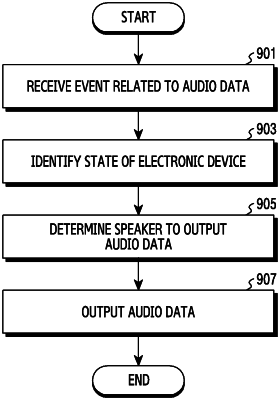| CPC H04R 3/12 (2013.01) [H04R 1/227 (2013.01); H04S 7/301 (2013.01); H04S 7/307 (2013.01); H04R 2499/11 (2013.01)] | 18 Claims |

|
1. An electronic device comprising:
a housing including a first housing having a first surface facing in a first direction, and a second housing having a second surface facing in a second direction;
a hinge unit rotatably connected to the first housing and the second housing;
a display exposed to an outside through the first surface of the first housing and the second surface of the second housing;
a first speaker disposed within the first housing;
a second speaker disposed within the second housing;
at least one sensor;
a processor operatively connected with the first speaker, the second speaker, and the at least one sensor; and
a memory operatively connected with the processor,
wherein the memory is configured to store instructions that, when being executed, cause the processor to:
receive a user input for receiving audio data from another electronic device after receiving an event related to a call reception from the other electronic device,
output the audio data through the first speaker which is set by default,
identify whether a state of the electronic device corresponds to a flat state, a folded state or an intermediate state, based on information acquired through the at least one sensor,
determine whether to output the audio data through the second speaker in addition to the first speaker which is outputting the audio data, based on the identified state of the electronic device, and
output the audio data through at least one speaker of the first speaker and the second speaker based on the determination.
|